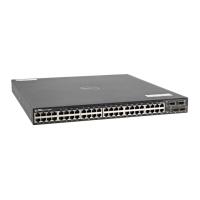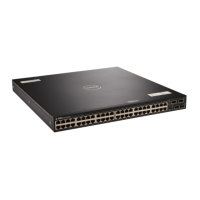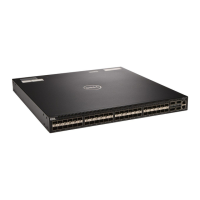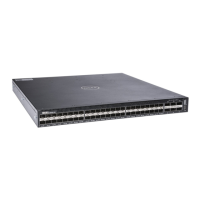VRF: 2 vrf2
State: Master, Priority: 100, Master: fe80::201:e8ff:fe8a:e9ed (local)
Hold Down: 0 centisec, Preempt: TRUE, AdvInt: 100 centisec
Accept Mode: FALSE, Master AdvInt: 100 centisec
Adv rcvd: 0, Bad pkts rcvd: 0, Adv sent: 443
Virtual MAC address:
00:00:5e:00:02:ff
Virtual IP address:
10:1:1::255 fe80::255
Dell#show vrrp vrf vrf2 port-channel 1
Port-channel 1, IPv6 VRID: 255, Version: 3, Net: fe80::201:e8ff:fe8a:fd76
VRF: 2 vrf2
State: Backup, Priority: 90, Master: fe80::201:e8ff:fe8a:e9ed
Hold Down: 0 centisec, Preempt: TRUE, AdvInt: 100 centisec
Accept Mode: FALSE, Master AdvInt: 100 centisec
Adv rcvd: 548, Bad pkts rcvd: 0, Adv sent: 0
Virtual MAC address:
00:00:5e:00:02:ff
Virtual IP address:
10:1:1::255 fe80::255
Sample Configurations
Before you set up VRRP, review the following sample configurations.
VRRP for an IPv4 Configuration
The following configuration shows how to enable IPv4 VRRP. This example does not contain
comprehensive directions and is intended to provide guidance for only a typical VRRP configuration. You
can copy and paste from the example to your CLI. To support your own IP addresses, interfaces, names,
and so on, be sure that you make the necessary changes. The VRRP topology was created using the CLI
configuration shown in the following example.
Virtual Router Redundancy Protocol (VRRP)
1133
